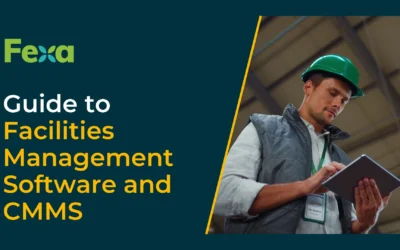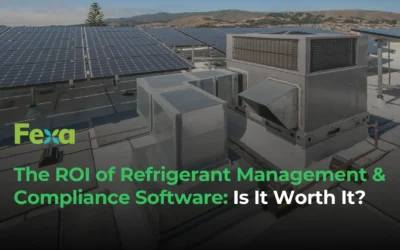AIM ACT
Asset Inventory Checklist:
How to Prepare for AIM Act Changes
The EPA has issued its final ruling under the American Innovation and Manufacturing (AIM) Act, introducing significant changes to record-keeping requirements for HFC systems.
Understanding these changes is crucial to avoid fines and ensure compliance. At Fexa Trakref, we’re here to help you navigate through the process before these regulations take effect.
How to Know If You’re Affected
Here are the following conditions that determine if your organization is affected by these new regulations:
- New Leak Repair Requirements: If you operate commercial or industrial process refrigeration systems, you must implement leak repairs for systems with a refrigerant charge of 15 lbs or more. This includes both HFC refrigerants and substitutes with a Global Warming Potential (GWP) of 53 or greater.
- Mandatory Automatic Leak Detection Systems: If your facility uses commercial or industrial process refrigeration systems with a capacity of 1,500 lbs or more, you are required to have automatic leak detection systems in place for both new and existing equipment containing HFC refrigerants or their substitutes with a GWP of 53 or greater.
Asset Inventory Checklist:
What Information Should You Gather About Your Assets?
For industrial process refrigeration, commercial refrigeration, and comfort cooling, here’s the most important information you will need, what they are, and why they’re important:
| Checklist Item | Description | Importance |
| Asset Type | Determine if it’s comfort cooling, commercial refrigeration, or industrial process refrigeration | Helps in understanding the leak rate threshold |
| Refrigerant Type | Identify the refrigerant and its GWP type | Essential for compliance; check GWP of the refrigerant |
| Capacity | Know the size of the system | Determines refrigerant volume and applicable regulations |
| Unique Identification | Use asset or tag names for clarity | Clarifies which asset is being discussed; avoids confusion |
| Model Number | Collect the manufacturer’s information about the asset | Useful for looking up asset information |
| Manufacturer | Identify who made the asset | Supports the model number in identifying asset specifics |
Checklist for Automatic Leak Detection Systems (ALDs)
For automatic leak detection systems, here’s the most important information you will need, what they are, and why they’re important:
| Item | Description | Importance |
| Asset | Which system is this Automatic Leak Detection (ALD) monitoring? | Indicates which assets have ALDs and shows a parent-child relationship to help monitor leaks. |
| Unique Identification | Asset name or tag name for clarity. | Critical for determining calibrated ALDs and the systems they monitor. |
| Device Type | Is it self-calibrating, concentration, or parametric? | Identifies the ALD device type and its leak monitoring capabilities. |
| Detection Limit | What is your detection limit for refrigerants? | Refers to the lowest detectable amount of a refrigerant by the ALD. |
| Alarm Set Point | What is the alarm set point for the asset? | Concentration level at which the ALD alarms for potential leaks. |
| Manufacturer | Who made the ALD? | Useful for looking up ALD data, especially during calibrations. |
What’s Next?
As you prepare for the upcoming changes to the AIM Act, it’s essential to conduct thorough asset surveys and gather necessary information about your systems. For technicians, this means collecting detailed data about each asset onsite, regardless of its size. Nameplates usually provide a wealth of information, but technicians familiar with the equipment can often fill in any gaps.
If your large systems lack Automatic Leak Detection (ALD) setups, now is the time to prioritize their installation and documentation. Collaborate with your technicians to ensure you have the right information and budget for implementing ALDs. This proactive approach will not only enhance compliance but also help avoid costly operational disruptions.
Remember, there’s still time to prepare—record-keeping requirements won’t take effect until January 1, 2026. Use this window to get your asset management in order and stay ahead of the curve.
Get Ahead of the AIM Act with Trakref
Trakref simplifies refrigerant management and helps ensure compliance with evolving regulations. With our comprehensive platform, you can easily track asset information and manage ALDs effectively.
Contact us to learn more about these changing regulations and how we can help your team ensure audit-ready compliance while making better use of service event data to better manage the cost and carbon impact of your operations.
Get Ahead of the AIM Act
Blog
Related Articles
Stay ahead of the curve with our insightful articles, expert opinions, and innovative trends. We are committed to providing you with valuable information and industry insights to help you optimize and manage your facility more effectively.
Guide to Facilities Management Software and CMMS
FACILITIES MANAGEMENT / FEXA CMMSGuide to Facilities Management Software and CMMSHere's your ultimate guide to selecting the right facilities management software.Every time one of your facilities experiences a maintenance failure or equipment breakdown, it impacts...
The ROI of Refrigerant Management & Compliance Software: Is It Worth It?
ARTICLEThe ROI of Refrigerant Management & Compliance Software: Is It Worth It?Explore how refrigerant management software reduces costs, improves efficiency, and ensures compliance.Effective refrigerant management is no longer just a regulatory requirement—it’s a...
11 Signs It’s Time to Switch Your CMMS
ARTICLE11 Signs It’s Time to Switch Your CMMS Learn how upgrading to the right platform can streamline your operations and boost your bottomline.Your CMMS is supposed to make maintenance management easier, no matter how many facilities you are responsible for. But...





